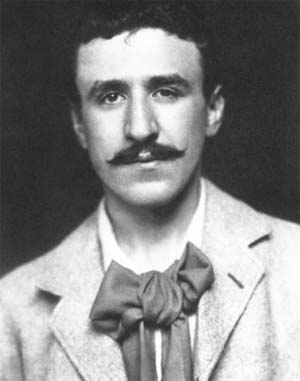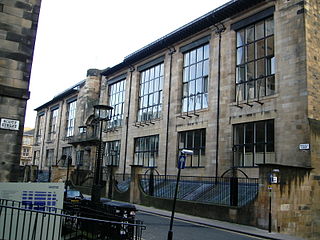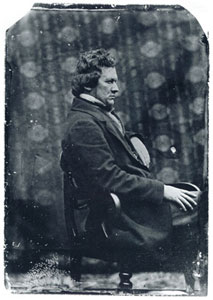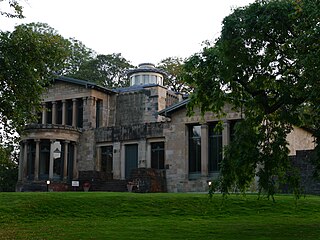
Charles Rennie Mackintosh was a Scottish architect, designer, water colourist and artist. His artistic approach had much in common with European Symbolism. His work, alongside that of his wife Margaret Macdonald, was influential on European design movements such as Art Nouveau and Secessionism and praised by great modernists such as Josef Hoffmann. Mackintosh was born in Glasgow and died in London. He is among the most important figures of Modern Style.

Clydesdale Bank is a trading name used by Clydesdale Bank plc for its retail banking operations in Scotland.

The Glasgow School of Art is a higher education art school based in Glasgow, Scotland, offering undergraduate degrees, post-graduate awards, and PhDs in architecture, fine art, and design.

The Hunterian is a complex of museums located in and operated by the University of Glasgow in Glasgow, Scotland. It is the oldest museum in Scotland. It covers the Hunterian Museum, the Hunterian Art Gallery, the Mackintosh House, the Zoology Museum and the Anatomy Museum, which are all located in various buildings on the main campus of the university in the west end of Glasgow.

Alexander "Greek" Thomson was an eminent Scottish architect and architectural theorist who was a pioneer in sustainable building. Although his work was published in the architectural press of his day, it was little appreciated outside Glasgow during his lifetime. It has only been since the 1950s and 1960s that his critical reputation has revived—not least of all in connection with his probable influence on Frank Lloyd Wright.

Pollokshields is an area in the Southside of Glasgow, Scotland. Its modern boundaries are largely man-made, being formed by the M77 motorway to the west and northwest with the open land of Pollok Country Park and the Dumbreck neighbourhood beyond, by the Inverclyde Line railway and other branches which separate its territory from the largely industrial areas of Kinning Park, Kingston and Port Eglinton, and by the Glasgow South Western Line running from the east to south, bordering Govanhill, Strathbungo, Crossmyloof and Shawlands residential areas. There is also a suburban railway running through the area.

Gillespie, Kidd & Coia was a Scottish architectural firm famous for their application of modernism in churches and universities, as well as at St Peter's Seminary in Cardross. Though founded in 1927, they are best known for their work in the post-war period. The firm was wound up in 1987.

The Willow Tearooms are tearooms at 217 Sauchiehall Street, Glasgow, Scotland, designed by internationally renowned architect Charles Rennie Mackintosh, which opened for business in October 1903. They quickly gained enormous popularity, and are the most famous of the many Glasgow tearooms that opened in the late 19th and early 20th century. The building was fully restored, largely to Mackintosh's original designs, between 2014 and 2018. It was re-opened as working tearooms in July 2018 and trades under the name "Mackintosh at The Willow". This follows a trademark dispute with the former operator of The Willow Tearooms which was resolved in 2017. That name is now used at tearoom premises in Buchanan Street and was additionally used at the Watt Brothers Department Store in Sauchiehall Street, Glasgow between 2016 and its closure in 2019.

Holmwood House is the finest and most elaborate residential villa designed by the Scottish architect Alexander "Greek" Thomson. It is also rare in retaining much of its original interior decor, and being open to the public. A Category A listed building, the villa is located at 61-63 Netherlee Road, Cathcart, in the southern suburbs of Glasgow, and is owned by the National Trust for Scotland.

St. Peter's Seminary is a former Roman Catholic seminary near Cardross, Argyll and Bute, Scotland. Designed by the firm of Gillespie, Kidd & Coia, it has been described by the international architecture conservation organisation Docomomo International as a modern "building of world significance". It is one of only 42 post-war buildings in Scotland to be listed at Category A, the highest level of protection for a building of "special architectural or historic interest". It has been abandoned since 1987, and is currently in a ruined state. In July 2020, the site was given to the Kilmahew Education Trust Ltd who plan to reinstate the educational elements of the Seminary Complex after conservation and restoration.
Dame Seona Elizabeth Reid is a Scottish arts administrator who was director of the Glasgow School of Art from 1999 to 2013, and former director of the Scottish Arts Council from 1990 to 1999.

The city of Glasgow, Scotland is particularly noted for its 19th-century Victorian architecture, and the early-20th-century "Glasgow Style", as developed by Charles Rennie Mackintosh.

Page\Park Architects was established in 1981 by David Page and Brian Park. It has developed one of Scotland's best known practices undertaking work over a range of sectors.

The Egyptian Halls is a category A listed building at 84–100 Union Street, Glasgow, Scotland. It was built between 1870–72 and designed by Alexander "Greek" Thomson. Other than some retailers on the ground floor, the building is currently unoccupied. Despite several attempts at restoration, it remains in a perilous state and was under threat of demolition in 2011. Planning approval and listed building consent has since been given for a scheme which has secured funding for conversion to a 114-bed four-star hotel. As of 20 February 2013, subsidy was still being sought for work to the ground floor.

St. Vincent Street, is one of the major streets in the city centre of Glasgow, Scotland. It was formed in the early 1800s as part of the residential New Town of Blythswood developed by William Harley of Blythswood Square. St. Vincent Street was named to commemorate the victory of Sir John Jervis, on 15 February 1797, off Cape Saint Vincent, Portugal. when the Royal Navy defeated the Spanish fleet which was on its way to join Napoleon's French fleet. The first part of the street, from George Square to Buchanan St, containing numbers up to 41, is named St Vincent Place.

John Keppie was a Glasgow architect and artist. From an early age he was a close friend of Edward Atkinson Hornel and would often bring in New Year with him in Kirkcudbright. Within the architectural profession, he was closest to John Archibald Campbell, and is credited with training Charles Rennie Mackintosh.

Gareth Dale Hoskins OBE was a Scottish architect.

The Clydesdale Bank £20 note is a sterling banknote. It is the third largest denomination of banknote issued by Clydesdale Bank. The current polymer note, first issued in 2020, bears a portrait of the Scottish king Robert the Bruce on the obverse and an image of the islands of St Kilda on the reverse.
























